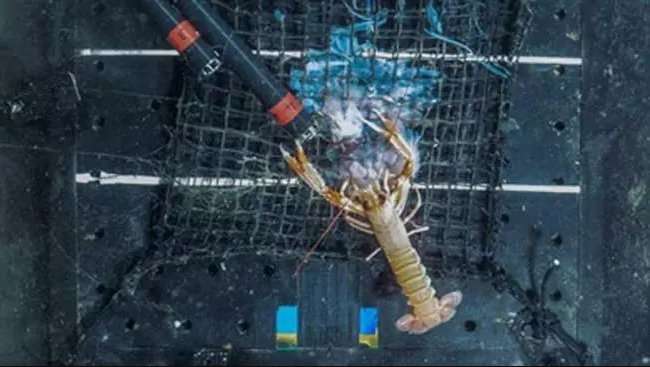Norway lobsters' appetite for jellyfish caught on camera

Norway lobsters' secret love of jellyfish has been caught on camera for the first time, raising questions about whether jellyfish blooms are pests or potential food sources for the commercial fishing industry.
Jellyfish blooms, the vast swarms that are appearing with increasing frequency in waters around the world, are thought to have highly negative effects on marine life and commercial fisheries.
But the scavenging that Heriot-Watt University scientists have caught on camera raises the question of whether the maligned gelatinous creature is actually a sustainable, rich food source for one of the Atlantic's most commercially important invertebrate species: the Norway lobster.
Dr. Andrew Sweetman, associate professor of marine benthic ecology in the Lyell Centre, reported his findings in Nature Scientific Reports. Dr. Sweetman worked with Kathy Dunlop from Akvaplan-nive Norway and Daniel Jones from the National Oceanography Centre, Southampton, to find out which deep-water species were most attracted by the prospect of a jellyfish dinner.
Two underwater camera systems were lowered to depths of over 250m in the Sognefjorden in western Norway, each baited with defrosted helmet jellyfish carcasses.
While the team had expected some of the usual scavengers to appear, like hagfish and amphipods, the team was surprised when 25-centimetre Norway lobsters rapidly located and decimated the jellyfish carcass.
Sweetman said, "We had no idea that Norway Lobster, which is worth £78 million to Scotland alone, fed on the jellyfish carrion that sinks to the depths, so it was very exciting to capture this on camera.
"The Norway lobsters' feasting was fast and furious. In both deployments, they located the jellyfish in under 25 minutes, scared the other scavengers away almost immediately and consumed over 50 per cent of the carcass.
"We looked at the nutritional value of the jellyfish, along with average Norway Lobster energy intakes in the Firth of Clyde, and found that just one of these jellyfish could satisfy the lobster's energy requirements for up to three months.
"Jellyfish have historically been considered a 'dead end' in the marine food chain, and it was only in 2012 that we discovered that anything was using it as a food source.
"To discover that it's a potentially huge food source for one of the Atlantic and North Sea's most commercially important catches is really interesting, and raises questions about how jellyfish could contribute to sustainable commercial fishing."
Although the experiment took place in Norway, Sweetman and colleagues are confident that the Norway lobsters in UK waters will have a similar appetite to the fjord-dwelling populations.
Sweetman said: "There are various species of jellyfish in Scottish waters and lochs, and I'm confident any Norway lobsters in those areas will also be feasting on the carrion.
"An interesting next step would be to find out how the Norway lobster are using the energy from the jellyfish. New techniques mean we could label jellyfish tissue with an isotope and trace it in the lobster—so we could actually tell whether it was going into reproductive cells, or helping general growth. That would be really fascinating."
More information: Kathy M. Dunlop et al. Direct evidence of an efficient energy transfer pathway from jellyfish carcasses to a commercially important deep-water species, Scientific Reports (2017). DOI: 10.1038/s41598-017-17557-x
Journal information: Scientific Reports
Provided by Heriot-Watt University




















